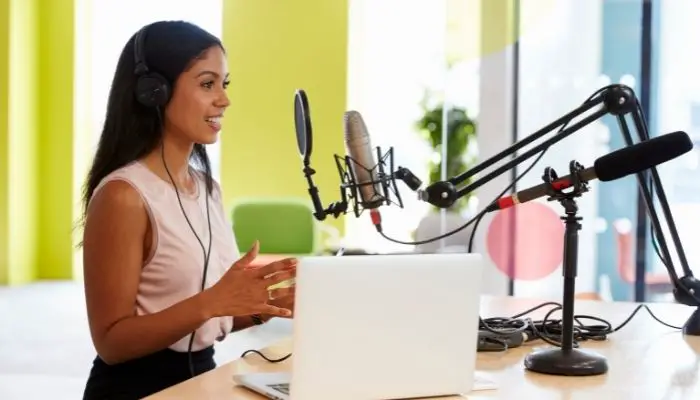If you own a Chromebook and enjoy using the Chrome OS, it stands to reason that you may also want to podcast on it as well.
Chromebooks are known for being secure devices that can offer speedy performance on lightweight hardware.
But does this also mean that podcasting on a Chromebook will be fast and efficient?
Table of Contents
Are Chromebooks Good for Podcasting?
If you have a newer Chromebook that can install the Linux development environment and run apps from the Google Play Store then it will be good for podcasting. However, If your Chromebook is too old to run Linux or Play Store apps you could still use web-based services like anchor.fm to record, edit, publish and distribute all of your podcast episodes.
You need to understand that you cannot download software onto Chromebooks in the same way as you can on Windows and Mac devices.
For example, on a Chromebook, you can’t go to the Adobe website and download and install Adobe Audition on your device to take care of all your podcast recording and editing needs. you’ll have to make do with cloud-based, Play Store and Linux apps which won’t be as powerful or feature-rich as the type of audio software you can download onto a Windows or Mac laptop.
However, Chromebooks hitting the shelves nowadays are becoming more competitive in the pure processing power arena, especially with the kind of competition that includes Microsoft’s Surface Pro Series of tablet and laptop hybrids and, of course, the Apple iPad.
The Chromebooks that most people are familiar with, like the kind that are designed for light browsing, streaming video content, and entertainment, are fading into the background of Chromebook history with newer and more powerful devices rising to the forefront.
Cloud-based apps and editing services are also becoming more powerful and feature-rich and can now cater to the vast majority of your podcasting needs.
Recording Audio on Your Chromebook

If there’s a major drawback to using a Chromebook, it’s that the Chrome OS isn’t something that is widely embraced by audio editing tools and the various software that’s necessary for putting together a well-edited podcast.
Fortunately, support in these areas is growing, with tools such as Spreaker coming immediately to mind.
The main thing that Podcasters want to do is get their voice out there and that means recording audio on your Chromebook with the associated editing tools to perfect the process.
There are 5 excellent audio recording tools for Chromebooks that you want to place on your radar.
- Reverb Record
- Spreaker
- Anchor
- Beautiful Audio Editor
- Vocaroo
Of the five in this list, Anchor is directed more towards podcasting, rather than just recording audio. However, all of these tools work well for recording your voice, saving the file, and putting it all together for your podcast.
Reverb Record is a basic audio recording tool that has the added benefit of adding it to your Chrome browser as an extension. When you finish your recording, you can save or embed the file with ease.
Vocaroo is a basic audio recording tool as well. It’s super easy to install, set up, and use. When you’re finished, you can easily send the URL, download it, or you can even create QR codes
Beautiful Audio Editor is the best of the bunch because it is a more in-depth and involved audio recording tool for your Podcasts and that’s mostly because of the editing tools that it comes with.
Editing Audio on Your Chromebook
Nobody speaks perfectly for an entire hour. Or, maybe one of your kids infiltrated your studio and made some background noise while you were recording.
Whatever, the reasoning, you have to edit your audio if you want to put forward the highest quality podcast that you can.
Audacity
One of the best audio editing software tools that you can get your hands on is Audacity and it is currently your best option for podcasting on a Chromebook. The only drawback is that you will have to set up Linux on your Chromebook to get your hands on it.
With Audacity, all of your audio imports will be smooth and problem-free. But even better, the number of tools at your disposal is impressive. You can combine multiple recordings with simple cut and paste tools.
That makes it easy for you to comment on the issues of the day in your genre by playing live samples of content that are interwoven seamlessly with your audio.
If you want your voice, background audio, and snippets to sound perfect, you have a compressor, phaser, limiter, reverb, and many other tools at your disposal.
There are a lot of audio editing software tools out there but if you’re just starting up your first podcast, Audacity is an excellent, beginner-friendly approach.
Installing Audacity On Your Chromebook
To install Audacity on your Chromebook, you’ll first have to turn on the Linux development environment, which your Chromebook should have if it didn’t come out before 2019.
Click on the time in the bottom right-hand side of the taskbar, click the settings icon and click the advanced section on the left-hand side panel, click on developers, turn on the Linux development environment, click next and hit install.
If you don’t see an option for a Linux development environment, it means your Chromebook is not going to be able to install Audacity.
You’ll now have an option for Linux apps in your launcher and you will be able to open up a terminal to input commands.
To ensure things are up to date, the first thing to do when you open the Linux terminal is to type in “sudo apt update” and hit enter.
Once that command has finished running, type in “sudo apt upgrade” and hit enter again.
Now you can install Audacity by typing “sudo apt install audacity” into the terminal and hitting enter.
You’ll be asked if you’d like to continue. Type “Y” to say yes and then hit enter.
Once the process has stopped and you see a message that includes @penguin displayed in green-colored text at the bottom of the command list, you can close the terminal.
You should now be able to see an Audacity icon in your launcher or among your Linux apps.
Setting Up Your Mic In Audacity
If your microphone doesn’t work right off the bat check to see if your microphone in Audacity is named either default Mic 0 or 1 or sysdefault: Mic 0 or 1.
These are usually the default mics used.
For Chrome OS 83 Or Higher
If they don’t work and your Chrome OS version is higher than 83, type “chrome://flags” into a web browser address bar and hit search.
Then, in the search bar on that web page search for “mic“.
Look for the flag named allow Crostini mic setting and change it from default to enabled.
You can also enable the flag that says modify mic gain in the system tray and hit restart. That just allows you to access the gain of your microphone from the bottom right-hand tray.
For Chrome OS 81 Or Lower
If your version of Chrome OS is 81 or lower you’ll need to open the Secure Shell App by hitting Control Alt T in an open browser window.
From here type in “vmc stop termina” and hit enter to shut down anything that’s currently running from Crostini.
Next, you’ll want to get things running again by typing “vmc start termina –enable-audio-capture” and hitting enter.
Now you can head back to Audacity and choose either default Mic 0 or 1 or sysdefault: Mic 0 or 1.
You’ll now need to go back into settings and to the Linux development environment (the same setting you enabled a few minutes ago).
Click the arrow at the side of this section and turn on the setting that allows Linux to access your microphone and then select shut down (which won’t shut down your Chromebook).
Finally, if you can’t hear your own audio playback, then you may need to change the audio output setting in Audacity.
Now you can run Audacity on your Chromebook and explore all of its features.
Related Article: Are Chromebooks Better Than Laptops? (All You Need To Know)
Publishing Your Podcast from a Chromebook
Anchor is one of the best podcasting tools on the Google Play Store and, better yet, it’s easy to migrate audio that you are editing on another software platform over to Anchor when you are ready to publish.
We’ll speak more on this below, but if you want to publish your podcasts from your Chromebook, then you want a Chromebook that works with the Google Play Store app, if for nothing other than getting Anchor.
Most Chromebooks from 2019 and newer can run Android apps and come with the Google Play Store enabled.
As a publishing tool, Anchor is the simplest and most intuitive experience available for Chromebooks (or at least for Chromebooks that have access to the Google Play Store.
Choosing a Chromebook for Podcasting
This is what it all boils down to. Your podcast begins and ends with your choice of Chromebook so you need to get it right the first time.
Versatility is the key well, that and a solid processor, plenty of RAM, and plenty of storage.
Get a Chromebook That Can Run Google Play Store Apps
One of the primary reasons for getting a Chromebook that has full access to the Google Play Store is Spreaker Studio. Spreaker is a Podcasting app that was designed specifically for the Chrome OS and it is an integral podcasting tool for Chromebook users.
Since it is designed for the app, Spreaker comes with all of the familiar tools that Chromebook users already easily identify with.
The app is designed to cater to all of your podcast creative ambitions.
Also, some of the above-listed software tools are found on the Google Play Store as well, such as Anchor.
There are numerous podcasting apps on the Google Play Store and more coming online all the time.
These apps are also becoming more and more powerful, so having access to the Google Play Store on your Chromebook is an admissible feature.
Other software tools for podcasting will have to be downloaded and you may have to jump through a few hoops—such as the Linux pathway above—to get the software you want on your Chromebook.
A Minimum of 8GB of RAM
The more RAM your processor has available to it, the easier time it will have and the faster your device will run.
The more programs you run the more RAM you eat up so it dictates that the more you have, the better.
When you are going over your audio recordings and developing them into a smooth-running podcast, you’re going to want the extra RAM to keep everything running smoothly.
Fortunately, Chromebooks are becoming more and more advanced, and it’s not too difficult to find one with plenty of RAM.
The Acer Chromebook Spin 13 is a good example to start with and it’s a popular choice for those who are just getting their toes wet in the music production industry.
Most budget Chromebooks come with 4GB of RAM but if you want to future proof your investment, I’d advise going for at least 8GB.
Intel Core i5
An Intel Core i5 will take care of most of your needs as a beginner and will even carry you well into a career in podcasting, especially if it is paired with plenty of RAM.
Pro Tools 12 is a pretty resource-intensive program and an i5 will handle it just fine, and programs like Audacity only require 2GB of RAM and 1GHz of processing speed.
While you won’t always need the processing speed that an i5 can offer, an Intel Core i5 is a well-rounded middle option, sandwiched between “overkill” and “not enough.”
A Minimum of 64GB of Storage
Storage is essential because you’re going to want the highest quality audio podcast that you can get your hands on and the higher the quality, the more storage that it will take up when you download your finished work.
Your storage will be responsible for holding all of your podcasts, along with all of the future podcasts you are currently working on. Audio will surprise you when it comes to how much storage it will eat up.
The storage that your Chromebook comes with might seem a little stingy but you can easily add more through the cloud and SD cards.
Go for a 13” Full HD Screen
While having the absolute best in viewing technology isn’t a must for podcasters, you want a large screen with at least a full HD resolution.
It makes it easier for you to edit for one and much easier to catch anything awry that should be edited out.
Having enough visual clarity allows you to be more creative as you video your podcasts and edit out anything unnecessary.
An awesome Chromebook for podcasting is the Google Pixelbook Go. It has up to an Intel Core i7, as much as 16GB of RAM, a 13.3-inch 4K LCD touchscreen, and up to 256GB of eMMC storage.
Good Sounding Speakers
Your speakers—and their level of quality—usually go hand-in-hand with the quality of your microphone.
The quality of both is essential.
If you want to be an effective editor, you need quality speakers to hear your playback with peak clarity and sound performance.
You can be an outstanding orator and if the sound you put out is garbage, people will tune out. So, you must be invested in sound monitors and speakers.
The sound monitor will provide you with the best ability to nitpick your way through your playback and perform the editing process.
Other Considerations
Battery life and portability are important as well, especially if you don’t always run your podcast out of one place.
Since most Chromebooks aren’t gaming machines, you’re probably pretty safe on battery power, but keep your eyes out for something that will run for at least 7 hours.
And don’t forget that if you opt for a 4K display, it’s going to seriously eat into that battery life.
Your Webcam is important too, however, 4k is a waste of money since most people watch podcasts on their phones and although phones are capable of 4k resolutions, even a discerning eye won’t catch the differences between 4k and full HD on a mobile device.
All Things Considered
It is perfectly reasonable to run a podcast with a Chromebook, especially if you are just starting and can’t afford to go all-in on a high-powered device. So long as you know the tools that you need, you can find the perfect Chromebook for all of your needs without breaking the bank.



